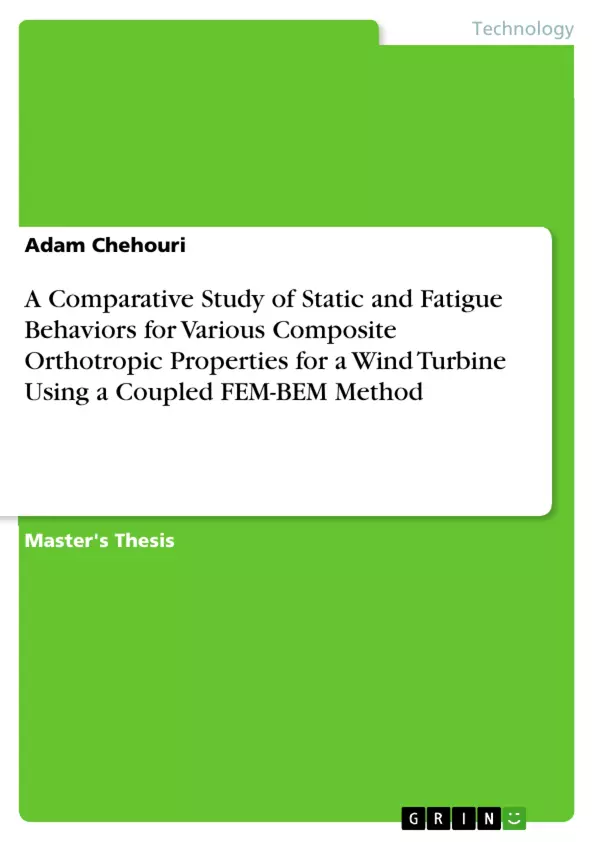In the wind industry, the current trend is towards building larger and larger
turbines. This presents additional structural challenges and requires blade materials that
are both lighter and stiffer than the ones presently used. This work is aimed to aid the
work of designing new wind turbine blades by providing a comparative study of different
composite materials.
A coupled Finite-Element-Method (FEM) - Blade Element Momentum (BEM) code was
used to simulate the aerodynamic forces subjected on the blade. The developed BEM
code was written using LabView allowing an iterative numerical approach solver taking
into the consideration the unsteady aerodynamic effects and off –design performance
issues such as Tip Loss, Hub Loss and Turbulent Wake State therefore developing a more
rational aerodynamic model. For this thesis, the finite element study was conducted on
the Static Structural Workbench of ANSYS, as for the geometry of the blade it was
imported from a previous study prepared by Cornell University. Confirmation of the
performance analysis of the chosen wind turbine blade are presented and discussed blade
including the generated power, tip deflection, thrust and tangential force for a steady flow
of 8m/s.
The elastic and ultimate strength properties were provided by Hallal et al. The Tsai-
Hill and Hoffman failure criterions were both conducted to the resulting stresses and
shears for each blade composite material structure to determine the presence of static
rupture. A progressive fatigue damage model was conducted to simulate the fatigue
behavior of laminated composite materials, an algorithm developed by Shokrieh.
It is concluded that with respect to a material blade design cycle, the coupling between a
finite element package and blade element and momentum code under steady and static
conditions can be useful. Especially when an integration between this coupled approach
and a dynamic simulation tool could be established, a more advanced flexible blade
design can be then analyzed for a novel generation of more flexible wind turbine blades.
Inhaltsverzeichnis (Table of Contents)
- CHAPTER I: Literature Review
- 1.1 Background
- 1.2 Scopes and Aims
- CHAPTER II: Aerodynamic Modeling
- 2.1 Methods for Calculating Aerodynamic Forces
- 2.2 BEM Model
- 2.2.1 Introduction
- 2.2.2 BEM Theory
- 2.2.3 Correction Models
- CHAPTER III: Structural Modeling
- 3.1 Blade Design
- 3.2 Blade Model
- 3.3 Load Application
- 3.3.1 Chord Length, Aerodynamic Centre and Twist Angle
- 3.3.2 Load Application and Moment Correction
- 3.4 Material Elastic Properties
- 3.5 Static Failure Criteria's
- CHAPTER IV: Results
- 4.1 Static Failure: Interlock Textures
- 4.2 Static Failure: Orthogonal Laminates
- 4.3 Static Failure: Braded Textures
- CHAPTER V: Fatigue Model
- 5.1 Overview
- 5.2 Progressive Fatigue Damage Model
- CONCLUSION & FUTURE WORK
- ANNEX
- A. Aerodynamic Blade Data
- B. BEM Model Verification
- C. Progressive Fatigue Damage Model
- REFERENCES
Zielsetzung und Themenschwerpunkte (Objectives and Key Themes)
This thesis examines the static and fatigue behaviors of various composite materials for wind turbine blades, focusing on the development and application of a coupled Finite-Element-Method (FEM) - Blade Element Momentum (BEM) code. The objective is to provide insights into the design of new wind turbine blades by comparing the performance of different composite materials under both static and dynamic conditions.- Comparative analysis of different composite materials for wind turbine blade design.
- Development and application of a coupled FEM-BEM code for aerodynamic force simulation.
- Investigation of static and fatigue behaviors of laminated composite materials.
- Assessment of the impact of material properties on blade performance.
- Exploration of the potential for more advanced flexible blade designs for future wind turbine generations.
Zusammenfassung der Kapitel (Chapter Summaries)
This report examines the structural performance of different composite materials under various static and fatigue loading conditions. It focuses on a comprehensive analysis of wind turbine blades, encompassing their aerodynamic, structural, and fatigue characteristics. Chapter I provides a review of relevant literature, encompassing existing methods for analyzing wind turbine blade performance, emphasizing the advantages and limitations of various approaches. This section lays the foundation for the research by highlighting the complexities and challenges associated with wind turbine blade design. Chapter II delves into the aerodynamic modeling aspects of the study. It focuses on the development and validation of a Blade Element Momentum (BEM) code using LabView. This chapter emphasizes the importance of accurate aerodynamic force calculations in the overall structural analysis of wind turbine blades. Chapter III dives into the structural modeling aspects of the study. It presents a detailed description of the chosen wind turbine blade geometry, including the blade design, material properties, and load application. The chapter also introduces the static failure criteria used to assess the structural integrity of the different composite materials. Chapter IV discusses the results of the static failure analysis, focusing on the performance of different composite materials under various loading conditions. This chapter sheds light on the strengths and weaknesses of different material configurations and provides valuable insights for material selection in future wind turbine blade designs. Chapter V explores the fatigue behavior of composite materials using a progressive fatigue damage model. This section addresses the critical issue of long-term durability and fatigue resistance in wind turbine blade design.Schlüsselwörter (Keywords)
This research report focuses on the analysis and comparison of different composite materials for wind turbine blades. The primary research areas include: * Wind turbine blade design * Aerodynamic modeling * BEM (Blade Element Momentum) code * FEM (Finite Element Method) * Composite materials * Orthotropic properties * Static failure analysis * Fatigue damage model * Dynamic simulation * Flexible blade design- Quote paper
- Adam Chehouri (Author), 2013, A Comparative Study of Static and Fatigue Behaviors for Various Composite Orthotropic Properties for a Wind Turbine Using a Coupled FEM-BEM Method, Munich, GRIN Verlag, https://www.grin.com/document/267156



